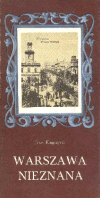Earlier, I was writing about joining Polacy nie gęsi – a challenge on reading Polish books. So, today’s review will be about a Polish book. A book on history of Warsaw, as the majority of the books I have been reading this month is about Warsaw, the city I was born in and in which I live.
Ladies and gentlemen! Let me introduce “Warszawa nieznana” by Jerzy Kasprzycki.
Warszawa nieznana – Jerzy Kasprzycki
 Title: Warszawa nieznana (Unknown Warsaw)
Title: Warszawa nieznana (Unknown Warsaw)
Author: Jerzy Kasprzycki
Language: Polish (afaik there is no English translation)
Published: 1982, by Krajowa Agencja Wydawnicza
Edition: 1st
Pages: 69 + illustrations
ISBN: N/A
About the author
Jerzy Kasprzycki (1930-2001) was Polish journalist and varsavianist [a person who researches the history of Warsaw or things related to it]. One of his best known works are “Pożegnania warszawskie” (Warsaw’s goodbyes) or the series of Warsaw’s districts’ books. He was rewarded several times for his publications, also by the city officials.
About the book
The author has collected stories from the long gone past and a recent past in 11 short chapters. Original titles with the page number and English translation are below.
- Ulice zaginione i odnalezione – 4 (The lost and found streets)
- Warszawa tele… – 8 (Tele… in Warsaw)
- Najkrótsza ulica – 13 (The shortest street)
- Inna strona Powstania Warszawskiego – 17 (The other side of The Warsaw Uprising)
- Warszawskie mocarstwo kolejowe – 22 (Warsaw train empire)
- Domy spółdzielcze sprzed pół wieku – 30 (The community houses from half a century ago)
- Warszawskie chlebki i bułeczki – 37 (Warsaw’s breads and buns)
- Tanie jak barszcz (Strójwąsa) – 40 (Cheap as (Strójwąs’) borstch)
- “Grańcówka” i prefabrykaty – 45 (Grańcówka and prefabricates) Grańcówka is a name of bricks produced by Casimir Granzow.
- Nowe dzielnice – 50 (New districts)
- Symbioza – 61 (Symbiosis)
All the stories in Warszawa nieznana are real, based on historical sources or his life experience. The story of Warsaw is told in focus on places, shops and workshops and people, giving a real life, feeling and charm to the – often dryly told – history of Warsaw.
Quote
Jednym z rzemiosł typowo warszawskich było od wieków piekarstwo. Gwoli ścisłości historycznej trzeba wprawdzie stwierdzić, ze warszawiacy zawsze raczej więcej pili, niż zakąszali chlebem: w 1620 r. doliczono się w tym mieście zaledwie piętnastu piekarzy wobec trzydziestu ośmiu piwowarów. Lekka zmiana tych proporcji nastąpiła dopiero na przełomie XVIII i XIX w., gdy – zwłaszcza podczas krótkotrwałego zaboru pruskiego w latach 1796-1806 osiedliło się w Warszawie wielu mistrzów piekarskich ze Śląska, z Saksonii, Bawarii i z innych ziem niemieckich. Na ogół przybysze bardzo szybko się polonizowali, zachowując przy tym przywiązanie do kościoła ewangelickiego.
Translation:
One of the typically Warsaw crafts for ages was baking. More historically accurately would be saying that citizens of Warsaw always rather drank more than snack bread: in 1620 it was counted that in the city were only 15 bakers as opposed to 38 brewers. A small change of this proportions happened only at the turn of the 18 and 19 century, when – especially during a short period of Prussian Partition in 1796 – 1806 – many bakery masters from Silesia, Saxony Bavaria and other German lands settled in Warsaw. Usually newcomers were turning themselves into Polish themselves very quickly, at the same time keeping their devotion to the Protestant church.
Quote comes from page 37, from the chapter “Warszawskie chlebki i bułeczki”.
My opinion
The stories are very absorbing and lightly written. The facts and data are well mixed with all the details and trivia.
The book is over 30 years old, but most of its content is still valid. The most faded things in this book are some of the street names, which no longer exist. A list of name changes or a map would be an advantage while reading this book.
All the enjoyment I had from reading the book can’t be changed even by odd opinion of the author defending the “monstrosities” in the city streets. Perhaps he had to write it like this, given the time it was published.
The biggest flaw of Warszawa nieznana by Jerzy Kasprzycki is the number of pages. Definitely too little! I’d like to read some more of the stories. Can’t be helped, I’ll have to reach out for the author’s other books. 😉 I got this book from my local library, if given a chance, I’d like to have a copy of it at home. In the best scenario, it would be a 2nd edition, adjusted to the nowadays streets. Even tho I’m not sure such a version exists. 😉
My rating: 8/10.
Did you read “Warszawa nieznana”? What’s your opinion? Do you agree with me?